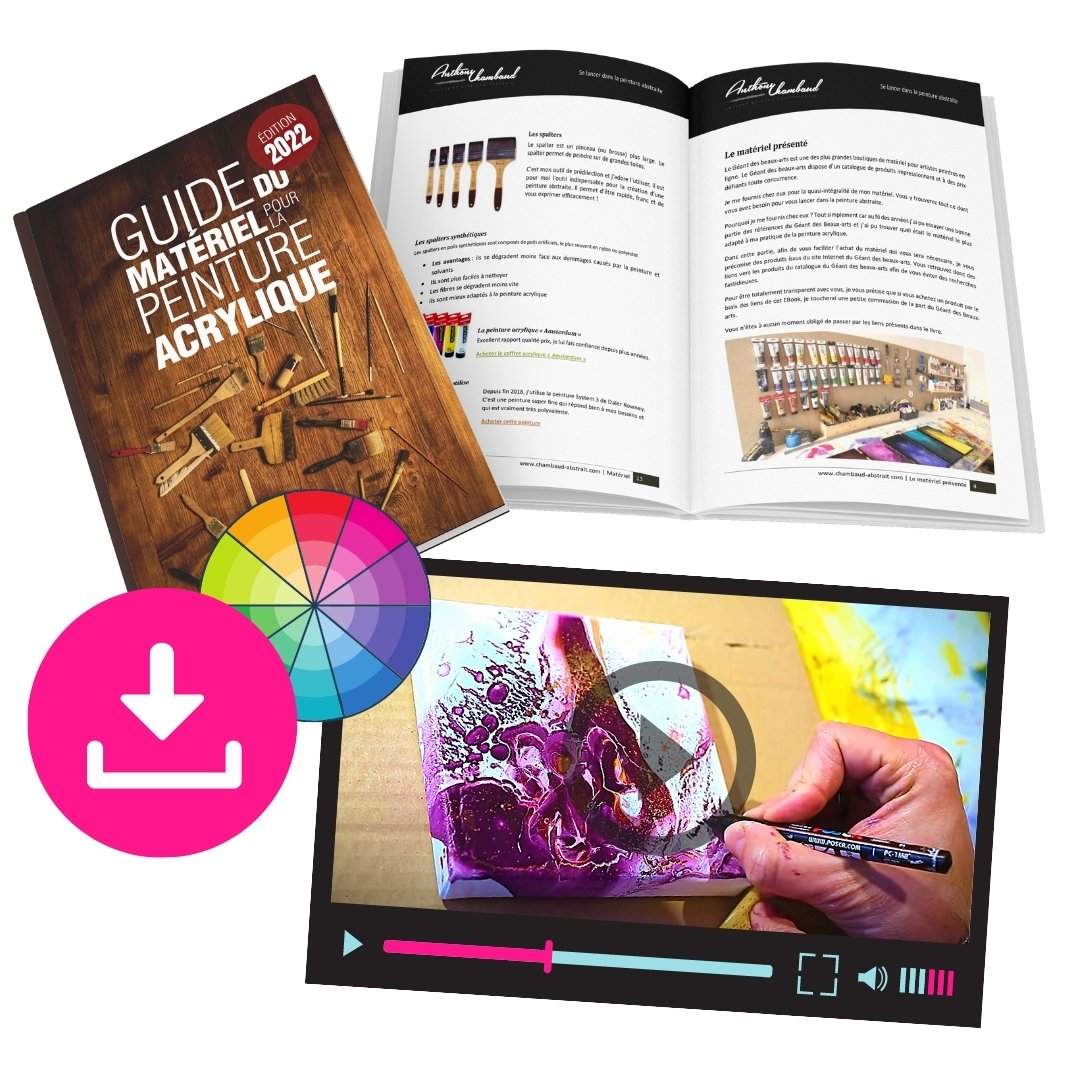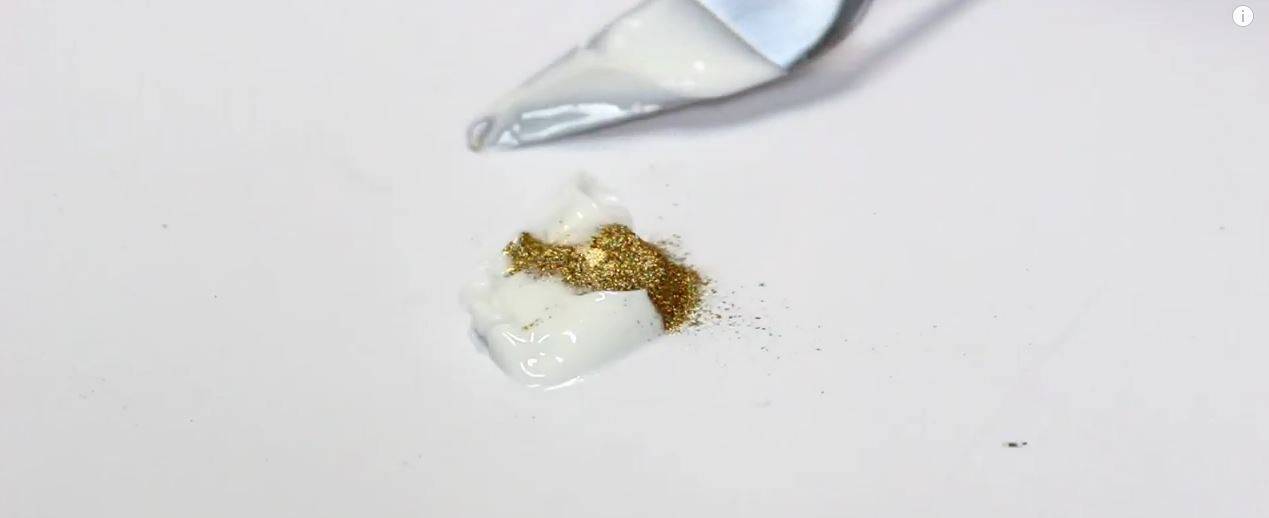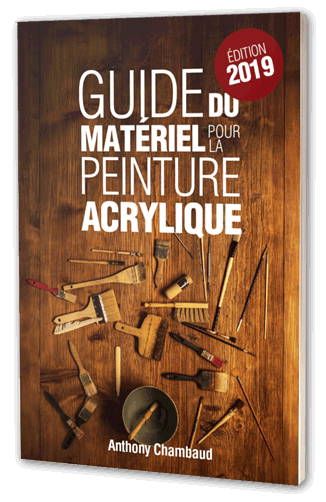(To see the video, click on the play button above)
Acrylic paint is generally easy to use, but there are some important rules to follow.
Here are the 13 mistakes and pitfalls to avoid when painting with acrylics.
Before you start
In this article, I often talk about material, the material I use for my acrylic painting practice.
If you’d like to know what equipment I use, and to find out how to purchase it, please download my equipment guide by clicking here.
Mistake 1: Using acrylic paint dry
A common mistake when starting out with acrylic paint is to use the paint straight from the tube, without any thinning agent.
This must be avoided at all costs, as the very principle of acrylic paint is its mixing with a diluting agent.
Solution
In most cases, acrylic paint is mixed with a thinner:
- Either water
- Or an acrylic binder such as Bindex
In my case, I usually use water.
The result is a smoother, more fluid paint. On the other hand, the more thinner you use in your paint, the more opacity you lose and the more transparency you gain.
Find out more
To find out more, check out my article on using acrylic paint.
Mistake n°2: Using brushes that are too thin
Contrary to what you might think, using a fine brush when you’re a beginner is neither advisable nor complex.
I recommend using a good-sized spalter, because the larger your brush/spalter, the easier it will be to cover your canvas without having to work with precision.
Mistake #3: Fear of making a mistake
Perhaps you’ve heard of this? You’re working on a painting, then an idea pops into your head, but for fear of ruining everything, you abandon the idea!
What a shame! You need to build up your self-confidence and experiment.
It’s experimentation that will lead you to make “good mistakes”. This is a very important phase in your acrylic painting apprenticeship, and a good way to find your own style over time!
Mistake No. 4: Using low-cost paint
I always prefer simple equipment, but there are limits.
What you need to avoid are school paints at €1 a tube from a brand you’ve never heard of.
In my case, I use fine paints (not extra-fine), which do the job very well. I use fine paints by Liquitex, Pebeo or Amsterdam.
Here are the disadvantages of first-price paint:
- Very different shade when drying
- Opacity problem: Too much transparency
- Can age badly and crack over time
- etc
If you’d like to understand the differences between fine and extra-fine paint, click here.
Mistake #5: Not using enough paint
A common beginner’s mistake: Not using enough paint.
Consequences:
- Hard-to-spread paint
- Tendency to use too much thinner : Inconsistent results
- Imperfections
You don’t need to economize too much, and use the right amount of paint. It’s something you’ll master with time and, above all, practice!
Mistake n°6: Striving for perfection(the best is the enemy of the good.)
I don’t know if you’ve heard the expression: “The best is the enemy of the good”.
I recently realized that many painters were using it.
Indeed, we must never strive for perfection, because perfection is intangible.
Of course you want your painting to be beautiful, magical, fairytale-like, but there comes a time when you have to be able to say stop and let go of the brushes!
Mistake 7: Starting with a large format
It’s only human when you’re just starting out that you sometimes want to skip stages.
But this is a trap to avoid, and you risk missing your first work…
Always opt for small formats, as this will help you get to grips with the medium, and over time you’ll gradually increase the size.
Mistake 8: Not mixing
To tame colors and create beautiful harmonies, it’s essential to mix and match.
Paint mixing has many advantages:
- Inexpensive
- space-saving: all you need are the three primary colors (Primary Yellow, Magenta & Cyan)
- With the three primary colors, you can create the majority of acrylic colors.
- This is the best way to learn chromatics and harmony instinctively.
Mistake 9: Trying to do everything on the same layer
Acrylic paint is fast-drying. Some people see this as a flaw, but I find it very practical!
This allows you to work layer by layer.
Don’t try to do it all in the same coat of acrylic paint – you’re heading for disaster.
Mistake #10: Using too many colors
Would you like to put all your favorite colors together in the same picture? Forget it!
It’s a trap you have to avoid. In most cases, you should start by using two, three or even four colors, but make sure there’s a real consistency in your choice.
For example, if you use two colors, you can use two complementary colors: violet and yellow.
If you want to master color harmonies, check out my digital book: Se Lancer dans la peinture abstraite.
Mistake n°11: Painting in detail
It’s one thing to work in detail, but you must always have an overall vision of the picture you’re creating.
To do this, take the time to look at your entire canvas when working in detail. You need to keep your eyes sharp and never take your eyes off your composition.
Mistake 12: Worrying about the result
You’re always afraid of the result, especially if the subject of your painting is abstract.
But I do have a few tips for you:
- You don’t have to put pressure on yourself
- You don’t have to prove anything to anyone
- I think the most important thing in practicing your art is: TO HAVE FUN!
Mistake no. 13: Trying to base your practice on outside advice
In an artistic career, you are often given advice:
- “This painting is nice but it would be better with blue”
- “Rather nice, but in this format it’s a shame…”
- etc
Good advice is of course always welcome, but you should never base your art on the wishes of others.
Your art is your own, and you shouldn’t change it to “please” others.
Pack offert : Techniques, matériel & guide
Pour vous lancer dans la peinture abstraite dans de bonnes conditions, je vous offre ce pack comprenant mon guide du matériel, un cours de peinture abstraite et une avalanche de conseils !

Continuer et télécharger









 Recevez votre Pack du peintre débutant
Recevez votre Pack du peintre débutant